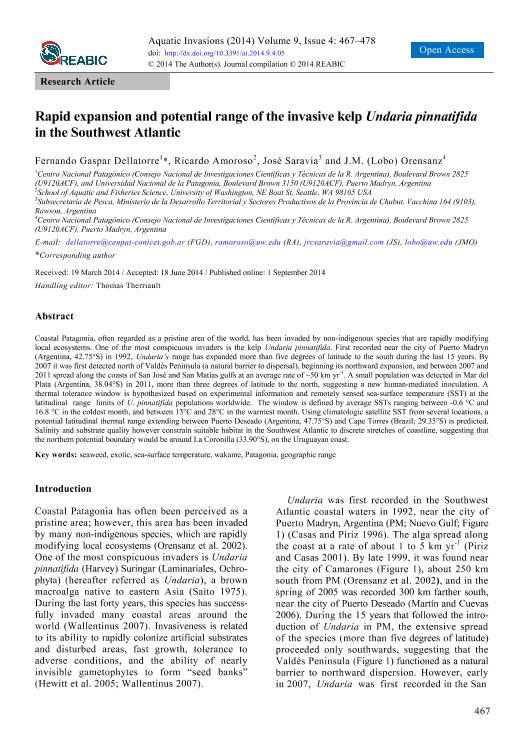Mostrar el registro sencillo del ítem
dc.contributor.author
Dellatorre, Fernando Gaspar

dc.contributor.author
Amoroso, Ricardo Oscar

dc.contributor.author
Saravia, José
dc.contributor.author
Orensanz, Jose Maria

dc.date.available
2016-09-19T19:23:58Z
dc.date.issued
2014-09
dc.identifier.citation
Dellatorre, Fernando Gaspar; Amoroso, Ricardo Oscar; Saravia, José; Orensanz, Jose Maria; Rapid expansion and potential range of the invasive kelp Undaria pinnatifida in the southwestern Atlantic; Regional Euro-Asian Biological Invasions Centre (REABIC); Aquatic invasions; 9; 4; 9-2014; 467-478
dc.identifier.issn
1798-6540
dc.identifier.uri
http://hdl.handle.net/11336/7658
dc.description.abstract
Coastal Patagonia, often regarded as a pristine confine of the world ocean, has been invaded by non-indigenous species that are rapidly modifying local ecosystems. One of the most conspicuous invaders is the kelp Undaria pinnatifida. First recorded near the city of Puerto Madryn (Argentina, 42.75°S) in 1992, during the last 15 years its range spread more than five degrees of latitude to the south. By 2007 it was first detected north of Valdes Península (a natural barrier), beginning its northward expansion, and between 2007 and 2011 spread along the coasts of San José and San Matías gulfs at an average rate of ~50 km yr-1. A small population was detected in Mar del Plata (Argentina, 38.04°S) in 2011, more than three degrees of latitude to the north, suggesting a new human-mediated inoculation. Based on experimental information and remotely sensed sea-surface temperature (SST) at the latitudinal range limits of U. pinnatifida populations worldwide, we hypothesize a thermal tolerance window between -0.6 °C and 16.8 °C average SST in the coldest month, and between 20 °C and 28 °C in the warmest month. Using climatologic satellite SST from several locations, we predict a potential latitudinal thermal range extending between Puerto Deseado (Argentina, 47.75°S) and Torres (Brazil; 29.35°S). Salinity and substrate quality however constrain suitable habitat in the southwestern Atlantic to discrete stretches of coastline, suggesting that the northern potential boundary would be around La Coronilla (33.90°S), on the Uruguayan littoral.
dc.format
application/pdf
dc.language.iso
eng
dc.publisher
Regional Euro-Asian Biological Invasions Centre (REABIC)
dc.rights
info:eu-repo/semantics/openAccess
dc.rights.uri
https://creativecommons.org/licenses/by-nc-sa/2.5/ar/
dc.subject
Seaweed
dc.subject
Exotic
dc.subject
Undaria
dc.subject
Wakame
dc.subject
Patagonia
dc.subject
Geographic Range
dc.subject.classification
Ecología

dc.subject.classification
Ciencias Biológicas

dc.subject.classification
CIENCIAS NATURALES Y EXACTAS

dc.title
Rapid expansion and potential range of the invasive kelp Undaria pinnatifida in the southwestern Atlantic
dc.type
info:eu-repo/semantics/article
dc.type
info:ar-repo/semantics/artículo
dc.type
info:eu-repo/semantics/publishedVersion
dc.date.updated
2016-09-14T17:37:25Z
dc.journal.volume
9
dc.journal.number
4
dc.journal.pagination
467-478
dc.journal.pais
Finlandia

dc.journal.ciudad
Helsinki
dc.description.fil
Fil: Dellatorre, Fernando Gaspar. Consejo Nacional de Investigaciones Científicas y Técnicas. Centro Nacional Patagónico; Argentina
dc.description.fil
Fil: Amoroso, Ricardo Oscar. Consejo Nacional de Investigaciones Científicas y Técnicas. Centro Nacional Patagónico; Argentina. University of Washington; Estados Unidos
dc.description.fil
Fil: Saravia, José. Provincia del Chubut. Ministerio de Desarrollo Territorial y Sectores Productivos; Argentina
dc.description.fil
Fil: Orensanz, Jose Maria. Consejo Nacional de Investigaciones Científicas y Técnicas. Centro Nacional Patagónico; Argentina
dc.journal.title
Aquatic invasions
dc.relation.alternativeid
info:eu-repo/semantics/altIdentifier/doi/http://dx.doi.org/10.3391/ai.2014.9.4.05
dc.relation.alternativeid
info:eu-repo/semantics/altIdentifier/url/http://www.aquaticinvasions.net/2014/issue4.html
Archivos asociados
